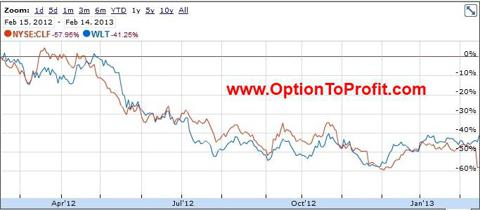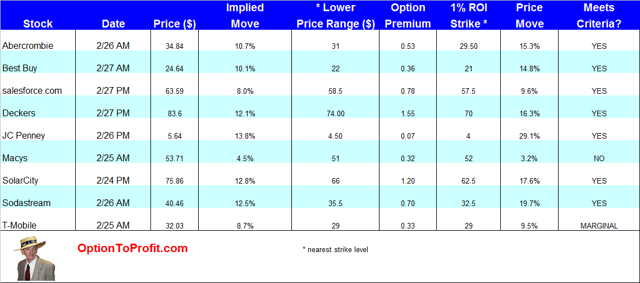 It’s all relative.
It’s all relative.
Sometimes it’s really hard to put things into perspective. Our mind wants to always compare objects to one another to help understand the significance of anything that we encounter. Having perspective, formed by collecting and remembering data and the environment that created that data helps to titrate our reaction to new events.
My dog doesn’t really have any useful perspective. He thinks that everyone is out to take what’s his and he reacts by loudly barking at everyone and everything that moves. From his perspective, the fact that the mailman always leaves after he has barked out reinforces that it was the barking that made him leave.
The stock market doesn’t really work the way human perspective is designed to work. Instead, it’s more like that of a dog. Forget about all of the talk about “rational Markets.” They really don’t exist, at least not as long as investors abandon rational thought processes.
It’s all about promises, projections and clairvoyance. Despite the superficial lip service given to quarterly comparisons no one really predicates their investing actions on the basis of what’s come and gone.
During earnings season one can see how all perspective may be lost. It’s hard to account for sudden and large price moves when there’s little new news. Although I can understand the swift reaction resulting in a 20% drop when Cliffs Natural Resources (CLF) announced that it was slashing its dividend, filing for a secondary stock offering and also creating a new class of mandatory convertible shares, I can’t quite say that the same understanding exists when Generac (GNRC) drops 10% following earnings and guidance that was universally interpreted as having “waved no red flags.”
Of course, the use of perspective and especially logic based upon perspective, can be potentially costly. For example, it’s been my perspective that Cliffs and Walter Energy (WLT) often follow a similar path.

What has been true for the past year has actually been true for the past five years. So it came as a surprise to me, at least from my perspective that the day after Cliffs Natural plunged nearly 20%, that Walter Energy, which reports earnings on February 20, 2013 would rise 6% in the absence of any news. From my perspective, that just seemed irrational.
But of course, perspective, by its nature has to be individually based. That may explain why Forbes, using its unique perspective on time, published an article on February 12, 2013, just hours before Cliffs released its earnings, that it had been named as the “Top Dividend Stock of the S&P Metals and Mining Select Industry Index”, according to Dividend Channel. In this case, Cliffs was accorded that august honor for its “strong quarterly dividend history.”
Apparently, history doesn’t extend back to 2009, when the dividend was cut by 55%, but it’s all in your perspective of things. I’m not certain where Cliffs stands in the ratings 24 hours later.
What actually caught my attention the most this past week is how performance can take a back seat to perspectives on liability, especially in the case of Halliburton (HAL) and Transocean (RIG). On Thursday, it was announced that a Federal judge approved a mere $400 million criminal settlement against it for its seminal part in the Deepwater Horizon blowout. That’s in addition to the already $1 Billion in fines it has been assessed. In return, Transocean climbed nearly 4%, while it’s frenemy Halliburton, on no news of its own climbed 6%. Poor British Petroleum (BP) which has already doled out over $20 Billion and is still on the line for more, could only muster an erasure of its early 2% decline. For Transocean, at least, the perception was that the amount wasn’t so onerous and that the end of liability was nearing.
From one perspective reckless environmental action may be a good strategy to ensure a reasonably healthy stock performance. At least that’s worked for Halliburton, which has outperformed the S&P 500 since May 24, 2010, the date of the accident.
I usually have one or more of the “Evil Troika” in my portfolio, but at the moment, only British Petroleum is there, at its lagged its mates considerably over the past weeks. Sadly, Transocean will no longer be offering weekly options, so I’m less likely to dabble in its shares, even as Carl Icahn revels in the prospects of re-instating its dividend.
Perhaps the day will come when stocks are again measured on the basis
of real fundamentals, like the net remaining after revenues and expenses, rather than distortions of performance and promises of future performance, but I doubt that will be the case in my lifetime.
In fact, the very next day on Friday, both Transocean and Walter Energy significantly reversed course. On Friday, the excuse for Transocean’s 5% drop was the same as given for Thursday’s 4% climb. Walter Energy was a bit more nebulous, as again, there was no news to account for the 3% loss.
So what’s your perspective on why the individual investor may be concerned?
As always, this week’s potential stock selections are classified as being either in the Traditional, Momentum, Double Dip Dividend or “PEE” categories (see data).
Technology stocks haven’t been blazing the way recently, as conventional wisdom would dictate as a basic building block for a burgeoning bull market. My biggest under-performing positions are in technology at the moment, patiently sitting on shares of both Microsoft (MSFT) and Intel (INTC). Despite Tuesday’s ex-dividend date for Microsoft, I couldn’t bear to think of adding shares. However, despite a pretty strong run-up on price between earnings reports, Cisco (CSCO) looks mildly attractive after a muted response to its most recent earnings report. Even if its shares do not move, the prospect of another quiet week yet generating reasonable income on the investment for a week is always appealing.
Although I was put shares of Riverbed Technology (RVBD) this week, which is not my favorite way of coming to own shares, it’s a welcome addition and I may want to add more shares. That’s especially true now that Cisco, Oracle (ORCL) and Juniper (JNPR) have either already reported or won’t be reporting their own earnings during the coming option cycle. With those potential surprises removed from the equation there aren’t too many potential sources of bad news on the horizon. The healing from Riverbed’s own fall following earnings can now begin.
MetLife (MET) is, to me a metaphor for the stock market itself. Instead of ups and downs, it’s births and deaths. Like other primordial forms of matter, such as cockroaches, life insurance will survive nuclear holocaust. That’s an unusual perspective with which to base an investing decision, but shares seem to have found a comfortable trading range from which to milk premiums.
Aetna (AET) on the other hand, may just be a good example of the ability to evolve to meet changing environments. Regardless of what form or shape health care reform takes, most people in the health care industry would agree that the health care insurers will thrive. Although Aetna is trading near its yearly high, with flu season coming to an end, it’s time to start amassing those profits.
It’s not easy to make a recommendation to buy shares of JC Penney (JCP). It seems that each day there is a new reason to question its continued survival, or at least the survival of its CEO, Ron Johnson, who may be as good proof as you can find that the product you’re tasked with selling is what makes you a “retailing genius.” But somehow, despite all of the extraneous stories, including rumored onslaughts by those seeking to drive the company into bankruptcy and speculation that Bill Ackman will have to lighten up on his shares as the battle over Herbalife (HLF) heats up, the share price just keeps chugging along. I think there’s some opportunity to squeeze some money out of ownership by selling some in the money options and hopefully being assigned before earnings are reported the following week.
The Limited (LTD) is about as steady of a retailer as you can find. I frequently like to have shares as it is about to go ex-dividend, as it is this coming week. With only monthly options available, this is one company that I don’t mind committing to for that time period, as it generally offers a fairly low stressful holding period in return for a potential 2-3% return for the month.
While perhaps one may make a case that Friday’s late sell-off on the leak of a Wal-Mart (WMT) memo citing their “disastrous” sales might extend to some other retailers, it’s not likely that the thesis that increased payroll taxes was responsible, also applied to The Limited, or other retailers that also suffered a last hour attack on price. Somehow that perspective was lacking when fear was at hand.
McGraw Hill (MHP) has gotten a lot of unwanted attention recently. If you’re a believer in government led vendettas then McGraw Hill has some problems on the horizon as it’s ratings agency arm, Standard and Poors, raised lots of ire last year and is being further blamed for the debt meltdown 5 years ago. It happens to have just been added to those equities that trade weekly calls and it goes ex-dividend this week. In return for the high risk, you might get
am attractive premium and a dividend and perhaps even the chance to escape with your principal intact.
I haven’t owned shares of Abercrombie and Fitch (ANF) for a few months. Shares have gone in only a single direction since the last earnings report when it skyrocketed higher. With that kind of sudden movement and with continued building on that base, you have to be a real optimist to believe that it will go even higher upon release of earnings.
What can anyone possibly add to the Herbalife saga? It, too, reports earnings this week and offers opportunity whether its shares spike up, plunge or go no where. I don’t know if Bill Ackman’s allegations are true, but I do know that if the proposition that you can make money regardless of what direction shares go is true, then I want to be a part of that. Of course, the problem. among many, is that the energy stored within the share price may be far greater than the 17% or so price drop that the option premiums can support while still returning an acceptable ROI.
Also in the news and reporting earnings this week is Tesla (TSLA). This is another case of warring words, but Elon Musk probably has much more on the line than the New York Times reporter who test drove one of the electric cars. But as with Herbalife and other earnings related plays, with the anticipation of big price swings upon earnings comes opportunity through the judicious sale of puts or purchase of shares and sale of deep in the money calls.
From my perspective these are enough stocks to consider for a holiday shortened week, although as long as earnings are still front and center, both Sodastream (SODA) and Walter Energy may also be in the mix.
The nice thing about perspective is that while it doesn’t have to be rational it certainly can change often and rapidly enough to eventually converge with true rational thought.
If you can find any.
Traditional Stocks: Aetna, Cisco, MetLife
Momentum Stocks: JC Penney, RIverbed Technology
Double Dip Dividend: The Limited (ex-div 2/20), McGraw Hill (ex-div 2/22)
Premiums Enhanced by Earnings: Abercrombie and Fitch (2/22 AM), Herbalife (2/19 AM), Tesla (2/20 PM)
Remember, these are just guidelines for the coming week. Some of the above selections may be sent to Option to Profit subscribers as actionable Trading Alerts, most often coupling a share purchase with call option sales. Alerts are sent in adjustment to and consideration of market movements, in an attempt to create a healthy income stream for the week with reduction of trading risk.
Some of the stocks mentioned in this article may be viewed for their past performance utilizing the Option to Profit strategy.
 While most of the more meaningful companies in the S&P 500 have already reported earnings and new earnings season is barely 7 weeks away, there’s still time to profit from remaining earnings reports coming this week.
While most of the more meaningful companies in the S&P 500 have already reported earnings and new earnings season is barely 7 weeks away, there’s still time to profit from remaining earnings reports coming this week. The table may be used as a guide for determining which of these selected companies meet the risk-reward parameters that an individual sets, understanding that re-assessments need to be made as prices and, therefore, strike prices and their premiums may change.
The table may be used as a guide for determining which of these selected companies meet the risk-reward parameters that an individual sets, understanding that re-assessments need to be made as prices and, therefore, strike prices and their premiums may change.
 Things aren’t always as they seem.
Things aren’t always as they seem. Generally, when you hear the words “perfect storm,” you tend to think of an unfortunate alignment of events that brings along some tragedy. While any of the events could have created its own tragedy the collusion results in something of enormous scale.
Generally, when you hear the words “perfect storm,” you tend to think of an unfortunate alignment of events that brings along some tragedy. While any of the events could have created its own tragedy the collusion results in something of enormous scale. 

 To summarize: The New York Post rumors, “The Dark SIde” and the FOMC.
To summarize: The New York Post rumors, “The Dark SIde” and the FOMC.

 It only seems fitting that one of the final big stories of the week that saw the Dow Jones eclipse its nearly 6 year old record high would be the latest reports of how individual banks performed on the
It only seems fitting that one of the final big stories of the week that saw the Dow Jones eclipse its nearly 6 year old record high would be the latest reports of how individual banks performed on the 

